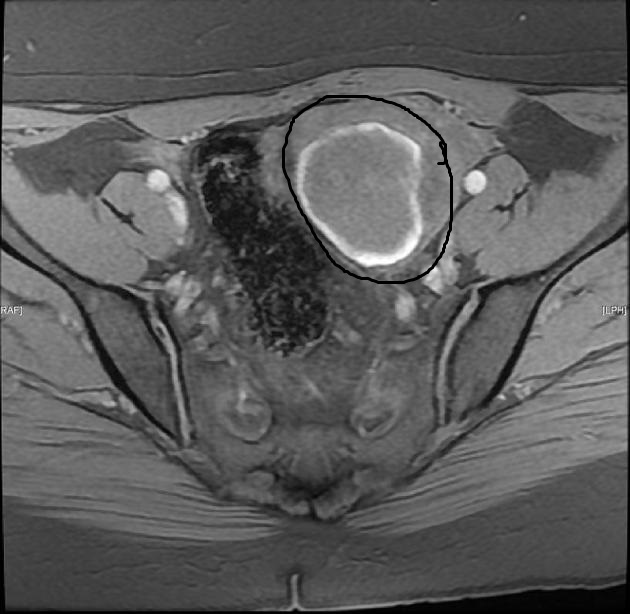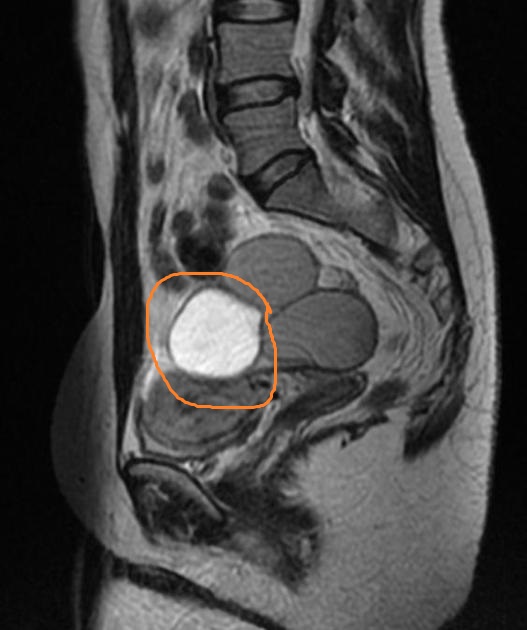Endometriosis MRI: Difference between revisions
Jump to navigation
Jump to search
No edit summary |
No edit summary |
||
| (20 intermediate revisions by 3 users not shown) | |||
| Line 5: | Line 5: | ||
==Overview== | ==Overview== | ||
[[MRI]] is | [[MRI]] is preferred over [[CT scan]] for the assessment of the anatomical locations and severity of the disease. The typical appearance of endometriosis includes a characteristic hyperintensity on T1-weighted images and a hypointensity on T2-weighted images. | ||
==MRI== | ==MRI== | ||
*MRI is the | *MRI is the diagnostic evaluation of choice to assess the locations of the [[Endometrium|endometrial]] [[lesions]] and to assess the severity of the disease.<ref name="pmid20093596">{{cite journal| author=Tanaka YO, Okada S, Yagi T, Satoh T, Oki A, Tsunoda H et al.| title=MRI of endometriotic cysts in association with ovarian carcinoma. | journal=AJR Am J Roentgenol | year= 2010 | volume= 194 | issue= 2 | pages= 355-61 | pmid=20093596 | doi=10.2214/AJR.09.2985 | pmc= | url=https://www.ncbi.nlm.nih.gov/entrez/eutils/elink.fcgi?dbfrom=pubmed&tool=sumsearch.org/cite&retmode=ref&cmd=prlinks&id=20093596 }} </ref><ref name="pmid19924468">{{cite journal| author=Grasso RF, Di Giacomo V, Sedati P, Sizzi O, Florio G, Faiella E et al.| title=Diagnosis of deep infiltrating endometriosis: accuracy of magnetic resonance imaging and transvaginal 3D ultrasonography. | journal=Abdom Imaging | year= 2010 | volume= 35 | issue= 6 | pages= 716-25 | pmid=19924468 | doi=10.1007/s00261-009-9587-7 | pmc= | url=https://www.ncbi.nlm.nih.gov/entrez/eutils/elink.fcgi?dbfrom=pubmed&tool=sumsearch.org/cite&retmode=ref&cmd=prlinks&id=19924468 }} </ref> | ||
*The typical appearance of [[Endometrium|endometrial]] lesions is a characteristic hyperintensity on T1-weighted images and a hypointensity on T2-weighted images.<ref name="pmid18477953">{{cite journal| author=Caramella T, Novellas S, Fournol M, Bafghi A, Mondot L, Chassang M et al.| title=[Deep pelvic endometriosis: MRI features]. | journal=J Radiol | year= 2008 | volume= 89 | issue= 4 | pages= 473-9 | pmid=18477953 | doi= | pmc= | url=https://www.ncbi.nlm.nih.gov/entrez/eutils/elink.fcgi?dbfrom=pubmed&tool=sumsearch.org/cite&retmode=ref&cmd=prlinks&id=18477953 }} </ref> | *The typical appearance of [[Endometrium|endometrial]] [[lesions]] is a characteristic hyperintensity on T1-weighted images and a hypointensity on T2-weighted images.<ref name="pmid18477953">{{cite journal| author=Caramella T, Novellas S, Fournol M, Bafghi A, Mondot L, Chassang M et al.| title=[Deep pelvic endometriosis: MRI features]. | journal=J Radiol | year= 2008 | volume= 89 | issue= 4 | pages= 473-9 | pmid=18477953 | doi= | pmc= | url=https://www.ncbi.nlm.nih.gov/entrez/eutils/elink.fcgi?dbfrom=pubmed&tool=sumsearch.org/cite&retmode=ref&cmd=prlinks&id=18477953 }} </ref> | ||
*Powder burn [[hemorrhages]]: | |||
**[[Lesions]] appear hyperintense on T1 and hypointense on T2. [[Adhesions]] and distortion of normal anatomy such as posterior displacement of the [[uterus]] and angulation of bowel loops.<ref name="pmid8796518">{{cite journal| author=Sugimura K, Imaoka I, Okizuka H| title=Pelvic endometriosis: impact of magnetic resonance imaging on treatment decisions and costs. | journal=Acad Radiol | year= 1996 | volume= 3 Suppl 1 | issue= | pages= S66-8 | pmid=8796518 | doi= | pmc= | url=https://www.ncbi.nlm.nih.gov/entrez/eutils/elink.fcgi?dbfrom=pubmed&tool=sumsearch.org/cite&retmode=ref&cmd=prlinks&id=8796518 }}</ref> | |||
*[[Uterosacral ligaments|Uterosacral]] involvement: | |||
**Irregular margins, asymmetry and nodularity and thickening medially. If bilateral [[Uterosacral ligaments|uterosacral]] involvement with additional involvement, torus uterinus involvement results in an arciform abnormality. | |||
*[[Vaginal]] involvement: | |||
**Loss of hypointense signal of the posterior vaginal wall on T2 thickening, nodules or masses may also be seen. | |||
*Partial to complete obliteration, suspended or lateralised fluid collections.<ref name="pmid10221244">{{cite journal| author=Kinkel K, Chapron C, Balleyguier C, Fritel X, Dubuisson JB, Moreau JF| title=Magnetic resonance imaging characteristics of deep endometriosis. | journal=Hum Reprod | year= 1999 | volume= 14 | issue= 4 | pages= 1080-6 | pmid=10221244 | doi= | pmc= | url=https://www.ncbi.nlm.nih.gov/entrez/eutils/elink.fcgi?dbfrom=pubmed&tool=sumsearch.org/cite&retmode=ref&cmd=prlinks&id=10221244 }}</ref> | |||
*[[Gastrointestinal tract]]: | |||
**Sensitivity may be increased with the use of water enema and endovaginal coils, rectal wall thickening, anterior displacement of the rectum, abnormal angulation, loss of fat plane between uterus and bowel inflammatory response due to repeated [[hemorrhage]] can lead to [[adhesions]], strictures, and [[Bowel obstruction|bowel obstructions]]. | |||
* [[Urinary system|Urinary tract]]: | |||
**Localized or diffuse bladder wall thickening, signal intensity abnormality. Nodules or masses usually located at the level of the vesicouterine pouch. | |||
*Chest: | |||
**MRI shows [[catamenial pneumothorax]], [[hemothorax]], and lung nodules. | |||
*Malignant transformation: | |||
**Change of MRI findings from cystic to solid enhancing components. | |||
[[File:Endo mri.jpg|500px| MRI showing endometriosis of the urinary bladder.]] | |||
[[File:94038d72166ae4182f9c5a18d52cfd big gallery.jpg|500px|MRI showing endometriosis of uterosacral ligament.]] | |||
==References== | ==References== | ||
{{Reflist|2}} | {{Reflist|2}} | ||
Latest revision as of 14:08, 3 August 2017
|
Endometriosis Microchapters |
|
Diagnosis |
|---|
|
Treatment |
|
Case Studies |
|
Endometriosis MRI On the Web |
|
American Roentgen Ray Society Images of Endometriosis MRI |
Editor-In-Chief: C. Michael Gibson, M.S., M.D. [1]; Associate Editor(s)-in-Chief: Aravind Kuchkuntla, M.B.B.S[2]
Overview
MRI is preferred over CT scan for the assessment of the anatomical locations and severity of the disease. The typical appearance of endometriosis includes a characteristic hyperintensity on T1-weighted images and a hypointensity on T2-weighted images.
MRI
- MRI is the diagnostic evaluation of choice to assess the locations of the endometrial lesions and to assess the severity of the disease.[1][2]
- The typical appearance of endometrial lesions is a characteristic hyperintensity on T1-weighted images and a hypointensity on T2-weighted images.[3]
- Powder burn hemorrhages:
- Uterosacral involvement:
- Irregular margins, asymmetry and nodularity and thickening medially. If bilateral uterosacral involvement with additional involvement, torus uterinus involvement results in an arciform abnormality.
- Vaginal involvement:
- Loss of hypointense signal of the posterior vaginal wall on T2 thickening, nodules or masses may also be seen.
- Partial to complete obliteration, suspended or lateralised fluid collections.[5]
- Gastrointestinal tract:
- Sensitivity may be increased with the use of water enema and endovaginal coils, rectal wall thickening, anterior displacement of the rectum, abnormal angulation, loss of fat plane between uterus and bowel inflammatory response due to repeated hemorrhage can lead to adhesions, strictures, and bowel obstructions.
- Urinary tract:
- Localized or diffuse bladder wall thickening, signal intensity abnormality. Nodules or masses usually located at the level of the vesicouterine pouch.
- Chest:
- MRI shows catamenial pneumothorax, hemothorax, and lung nodules.
- Malignant transformation:
- Change of MRI findings from cystic to solid enhancing components.
References
- ↑ Tanaka YO, Okada S, Yagi T, Satoh T, Oki A, Tsunoda H; et al. (2010). "MRI of endometriotic cysts in association with ovarian carcinoma". AJR Am J Roentgenol. 194 (2): 355–61. doi:10.2214/AJR.09.2985. PMID 20093596.
- ↑ Grasso RF, Di Giacomo V, Sedati P, Sizzi O, Florio G, Faiella E; et al. (2010). "Diagnosis of deep infiltrating endometriosis: accuracy of magnetic resonance imaging and transvaginal 3D ultrasonography". Abdom Imaging. 35 (6): 716–25. doi:10.1007/s00261-009-9587-7. PMID 19924468.
- ↑ Caramella T, Novellas S, Fournol M, Bafghi A, Mondot L, Chassang M; et al. (2008). "[Deep pelvic endometriosis: MRI features]". J Radiol. 89 (4): 473–9. PMID 18477953.
- ↑ Sugimura K, Imaoka I, Okizuka H (1996). "Pelvic endometriosis: impact of magnetic resonance imaging on treatment decisions and costs". Acad Radiol. 3 Suppl 1: S66–8. PMID 8796518.
- ↑ Kinkel K, Chapron C, Balleyguier C, Fritel X, Dubuisson JB, Moreau JF (1999). "Magnetic resonance imaging characteristics of deep endometriosis". Hum Reprod. 14 (4): 1080–6. PMID 10221244.

